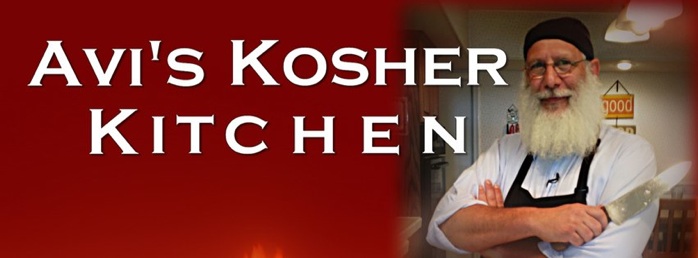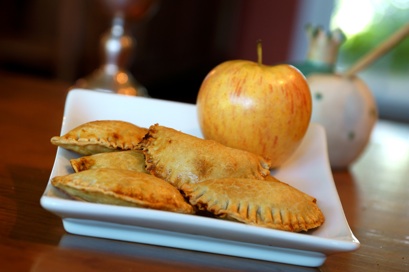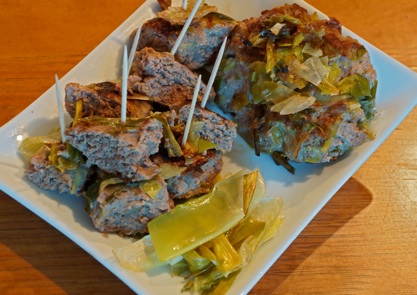Rosh HaShana Simanim:
More Than Appetizers


And interestingly, all this cooking has a direct relationship to the whole meaning of Rosh HaShana. Rosh HaShana is a lot more than a “New Year”, it’s a time of repentance and atonement. Even though we refer to Yom Kipper as the “Day of Atonement” we have to make our efforts at atonement beforehand. And food actually can help us do that.
Our sages tell us that our table is equivalent to the misba’ach, the altar in the Holy Temple. It was on this altar that people came to offer sacrifices to achieve atonement for their sins. According to Rabbi Chayim Palachi (Turkey) in his work Kaf HaChayim, when we eat at our tables and have the proper concentration and intent, the blessings we say over our food and the food we eat can actually work like a sacrifice for ourselves to achieve atonement for our sins. Pretty cool, especially at this time of year.
We all know that there is a custom to have various simanim (signs) on our table the night of Rosh HaShana. Arguably the most famous is apples dipped in honey, for a sweet new year. What many people don’t know is that there is actually a Sephardic (Jews of Spanish decent) custom to have a full seder of sorts on both nights of Rosh HaShana. In addition to apples dipped in honey, there are pomegranates, leeks, some sort of a gourd, usually a pumpkin, dates, beets, and the head of a lamb or of a fish.
Before eating any these simanim or denim as they’re also referred to, there is a special play on words that is said. They all start with the Hebrew phrase “Y’he Ratzon.” “May it be your desire . . .” Different Sephardic groups, Moroccans, Yemenites, Turks all have a slightly different order and some different customs as to the exact foods and how they’re prepared. But we all have the custom to eat these before our main meal.
The reason it’s important to have the food and eat it as opposed to just saying the phrase is because we must take action in order to effect change. If we want the coming year to be different, to be better, than it’s not just enough to say it and ask for it, we also have to put our own efforts forth. By preparing and eating these simanim with proper concentration and focus, we put into direct action the beginnings of change.
So, I thought I’d share two of my favorite recipes for the simanim. Being as my family traces its roots back to Turkey, these are from the “old country.”
Leek Prasas:
“May it be your will, L-rd our G-d, to cut off our enemies.” The Hebrew word for leek, karti is similar to the Hebrew term yi-karaytu, meaning to cut off.
Ingredients:
2-3 Leek Stalks cleaned and sliced
1 lb. of ground meat (Turkey, Lamb or Beef)
¼ cup oil
½ tsp. salt
3/4 Tbs. brown sugar
1 pinch of white pepper
2 pinches of cinnamon
1 large egg
1 -2 Tbs. matzo meal
If using lamb add the following:
1 pinch of cardamom
1 Tbs. mint sauce. (Fresh mint leaves crushed with a touch of salt simmered in wine vinegar and water, low heat.)
After the leeks have been thoroughly cleaned and checked for bugs, cut into strips and either boil in a pot of water until soft or sauté in the oil on low heat until soft. The water method gives you a base for a good veggie soup. The sauté method allows the sugars to caramelize in the leeks and gives you a sweeter leek.
Once the leeks are soft, cut them rustically into pieces that are about 1 to 2 inches. Then simply mix with all of the other ingredients except the oil. Then form the mixture into flat round patties about 3 inches in diameter. Make sure you indent the center with your thumb so that they don’t plump up too much when you cook them.
Now, you can either pan fry on medium heat with a touch of oil in the pan (especially if you choose turkey) or you can bake them in the oven at 400 until done, about 15 – 20 minutes.
The prasas can be cut into fourths and served with a toothpick in each for ease of handling.
Empanadas de Calabasa
“May it be your will, L-rd our G-d, and G-d of our Fathers, to tear up our evil decree and let out see our merits before you.” The Hebrew word for a gourd or squash is Kere similar to the word for tear – kria.

Anyway, you can make your own dough or just buy some premade sambusak dough, usually found in the freezer case of your local kosher store. It’s close but not the real deal. Here’s the recipe for the masa (boreka dough).
Ingredients:
1-cup vegetable oil
1-cup water
½ tsp salt
5 cups of flour
Put the oil, water and salt in a pot and bring to a boil. Allow it cool and when warm to the touch, add all of the flour and mix thoroughly. Take small walnut or golf ball size pieces form the dough and roll them out into flat rounds on some parchment paper. If you don’t have a rolling pin you can use a can or a sturdy glass.
The filling:
About 30 ounces of pumpkin puree
1 1/2-cups of brown sugar
2 Tbs cinnamon
1 ½ tsp. ground cloves
1 ½ tsp. nutmeg
3 eggs
1 cup of parve almond or soy milk
Dash or two of salt
The filling is made with either fresh pumpkin or canned pumpkin puree. This time of year it may be difficult, if not impossible to get fresh pumpkins. However, Libby’s canned pumpkin puree is kosher.
If you have a fresh pumpkin, simply cut it into fourths, scoop out all the seeds, (they can be roasted later for a healthy snack) and place in a 375-degree oven on a slightly oiled cookie sheet for about a half an hour until the ‘meat’ of the pumpkin is soft. Then let cool and when you can handle the pumpkin scrap out all of the ‘meat’ into a pot and use the rind for compost.
Once you have either the fresh pumpkin or are using 2 fifteen-ounce cans of pumpkin puree get them into a pot. Add all of the filling ingredients except the ‘milk’ to the pumpkin puree. Slowly add the milk until the mixture is creamy and let them mingle together over low to medium low heat until blended. You can feel free to adjust measurements to your taste. If you want to kick it up a bit you can add a shake of ginger or cardamom, or both if you’re daring.
Now just add a dollop or so of the filling to one side of the dough rounds. Then fold over the other half of the dough to make a “half-round” with the filling in the middle. Seal the overlapping edges with a pastry wheel or the tines of a fork. Lightly brush the tops with a beaten egg and then bake on either a lightly greased cookie sheet or on parchment paper (my preferred method) on a cookie sheet in a 375-degree oven until golden, about 30-45 minutes. But keep a close eye on them; you do not want these to burn.
They can be served warm or cold. The leftovers make a great snack and a great mini-dessert. They’re also great in morning with a cup of coffee.
Oh, one last recipe and siman. This is courtesy of my friend Rabbi Kalman Packous. Take a celery stalk and place a raisin in it. This is the sign for a raise in salary. (“Rais-in celery.)
And in case you were wondering, we use the fish head at my house. Easier to get and easier in the guests . . . well really all of us.
Have a beautiful, meaningful and successful Rosh HaShana. May your be inscribed for life, happiness and health.
L’Chaim . . . Avi
